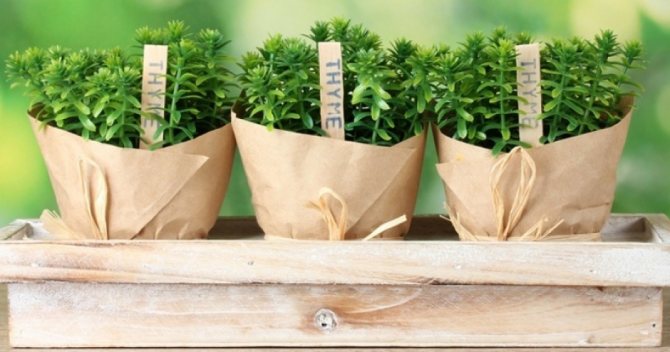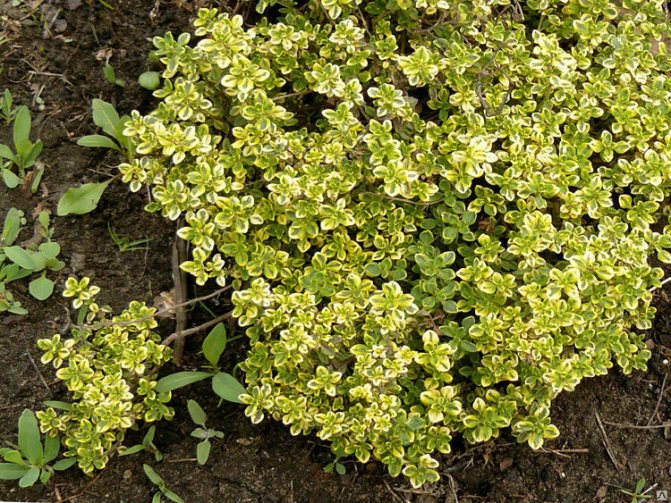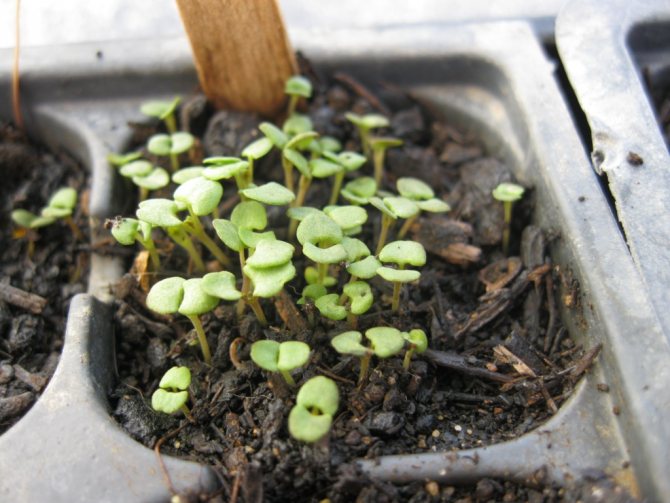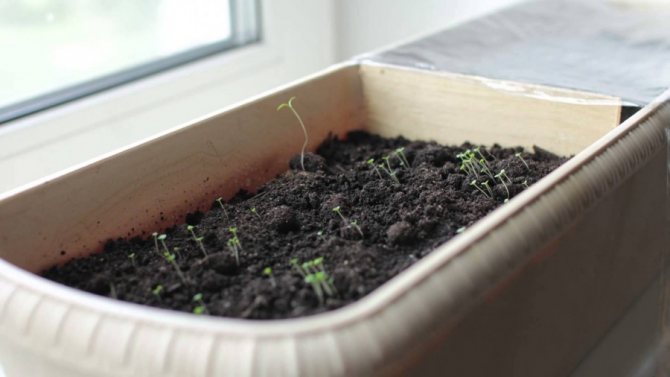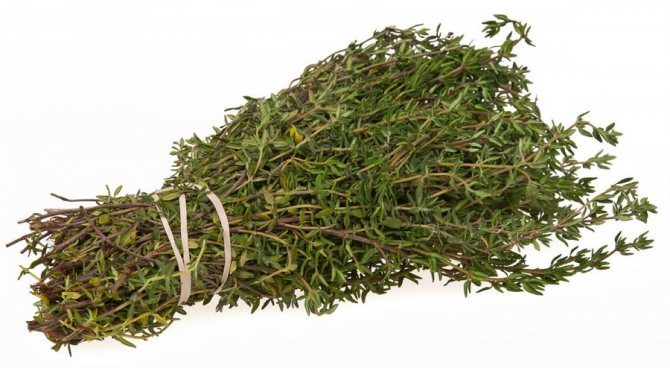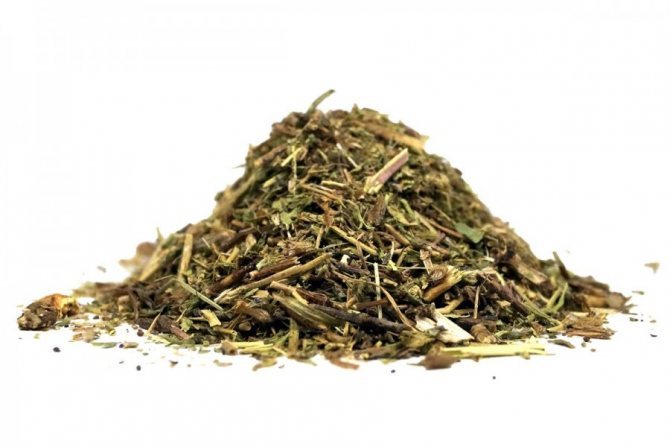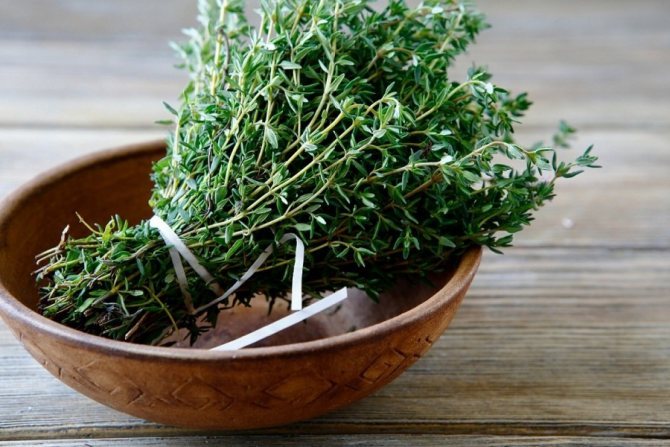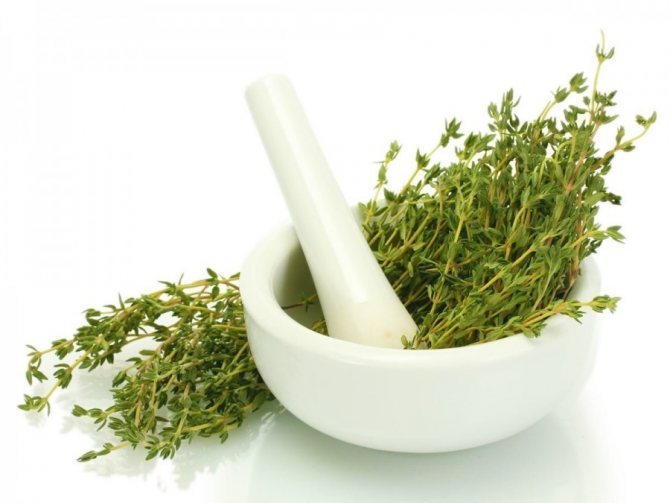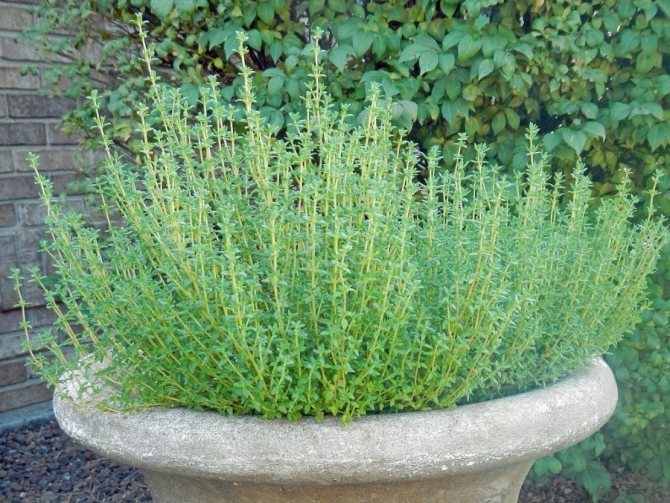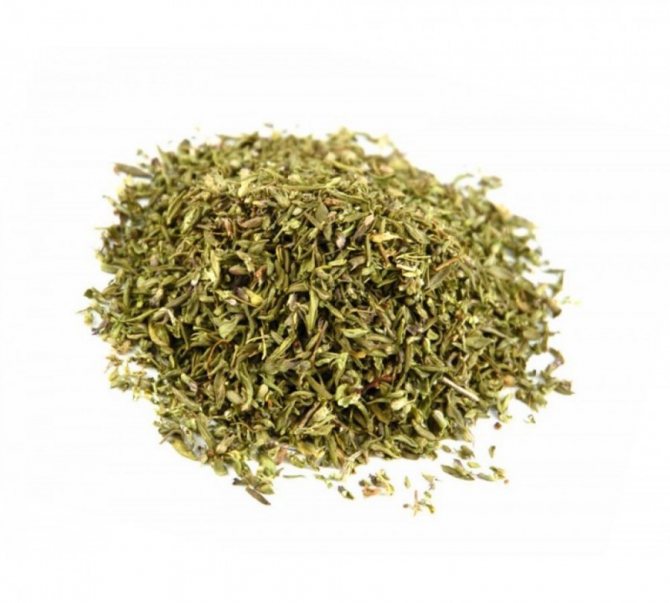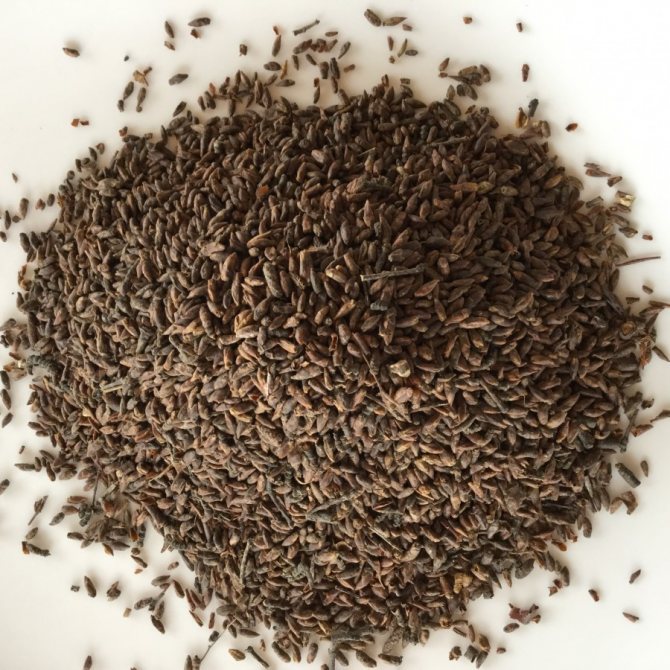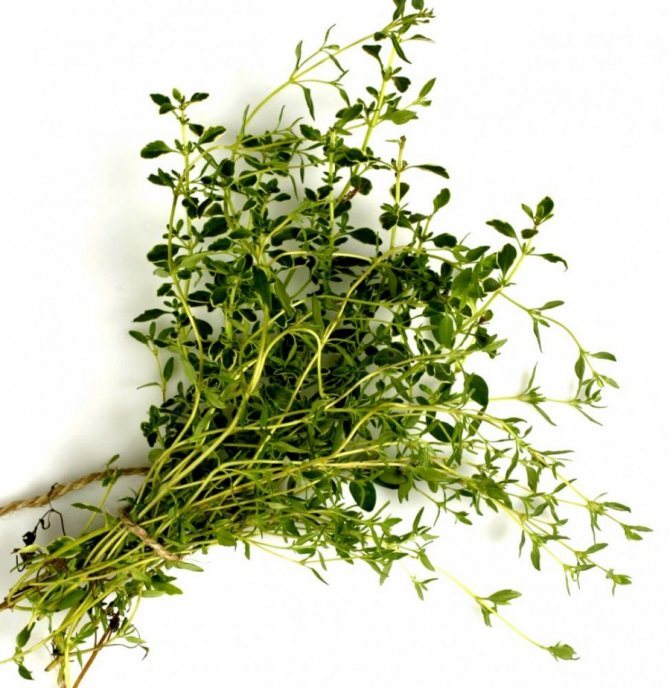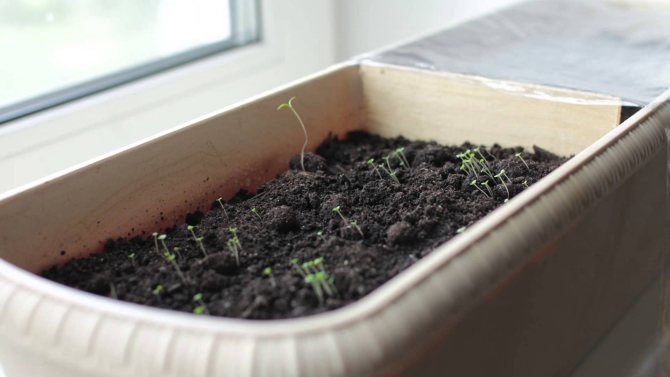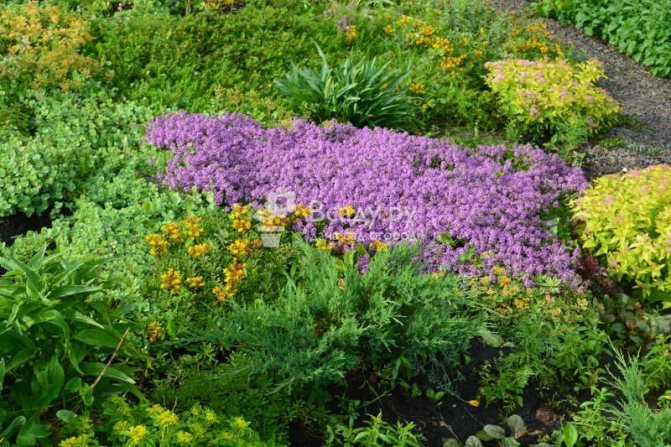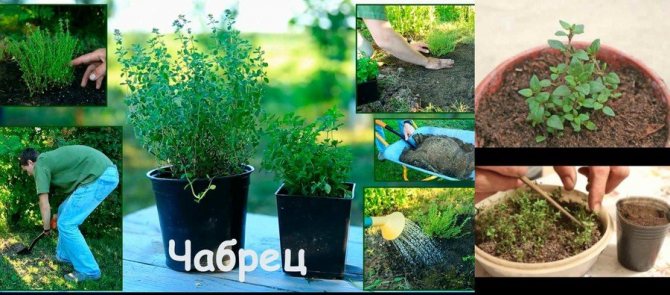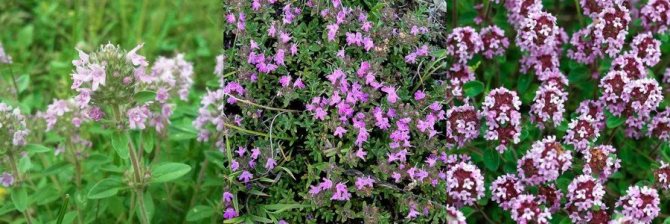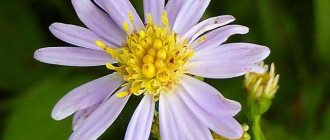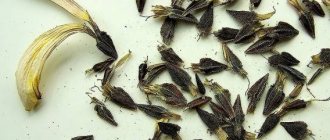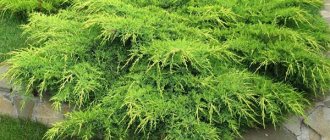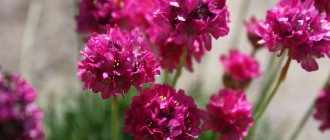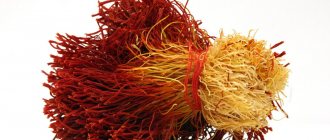Lemon-smelling thyme - description and characteristics
The plant is classified as a perennial crop. The first mention of it dates back to the sixteenth century. Lemon thyme originated by crossing flea and common thyme. For the winter, the plant must be covered, otherwise it will simply freeze out and die. Thyme has a delicate lemon aroma, thanks to this feature it is grown by many gardeners and gardeners.
Plant height is approximately 30-40 centimeters. The root system is powerful, small dense leaves are located on the lignified stem, most often they are bent inward. A spike-shaped inflorescence is located at the top. It is formed from bell-shaped flowers.
Interesting! Dried thyme, folded in a bag, will protect things from moths.
Care
Thyme Lemon – this is a plant that practically does not need special care. It is enough to fertilize it with compost or horny flour. He does not need more fertilizers. After the plant has faded, it needs to be pruned, thanks to this the bush will be dense and retain its beautiful shape. The stems are cut to the woody part. This is approximately two-thirds of the entire stem.
Thyme care is very easy
There is no need to water the plant. An exception is severe drought. Only during this period are the bushes lightly watered so that the thyme flowers remain colorful. In addition, thyme is resistant to diseases and pests. This feature cannot but attract gardeners to this plant. Thyme Lemon, whose reproduction and care are simple, will become a real decoration of the flower bed.
Lemon thyme varieties
More than 400 species of this plant grow in the world. Among the huge variety of lemon-flavored thyme, there are four of the most common. They are successfully grown all over the world.
Dona Valley
A perennial plant, its height ranges from 15 to 25 cm. The stem is slightly pubescent, covered with small, oval, dark green foliage. Yellowish spots are located along the perimeter of the leaf plate. The flowers are lilac, with a light scent of lemon, the smell becomes more pronounced if you rub any part of the plant.
The flowering period runs from June to July. The culture is drought-resistant, does not tolerate stagnant moisture. The variety grows rapidly, filling unplanned areas. It is used in cooking, it is a part of seasonings, and also as an ornamental plant.
Bertram Anderson
Most often planted for decorative purposes. Betram Anderson grows with a carpet, no more than 10 centimeters high. The foliage is golden, the flowers are lilac with a pink tint. Special conditions for care are not required; it is better to choose neutral soil for cultivation.
Silver Queen
The appearance is unremarkable. The leaves are green, with a white border around the edges. Thyme with a height of 20-30 cm grows well, in width it can reach 0.8 m. The flowers are lilac, the smell is pronounced, with notes of anise, caraway seeds and lemongrass. The scent attracts bees.
The variety is used in cosmetology, as well as in medicine, both official and folk. The plant is used to prepare infusions for the treatment of bronchitis and pneumonia. From the foliage, infusions are made, which are used for arthritis, gout, bruises, they have an analgesic effect.Thyme oil promotes wound healing and can help fight acne.
Golden Duarf
Golden Duarf Lemon Thyme is standard height, with bright green foliage about 1 centimeter in length. The flowers are small, pink with a rich aroma. The flowering period, unlike other varieties, is longer from June to August. Plants are distinguished by persistent immunity, they tolerate cold well, they are not attacked by harmful insects. The main condition for growth and proper development is a rich, moisture-intensive soil.
Popular varieties
Callistemon lemon: home care examples
Among florists, the following are very popular:
- Donna Varley is a low-growing variety of thyme that grows only up to 10 cm. The variety has small lilac flowers and very small leaves 0.5 cm in size;
- Silver Queen (Silver queen) grows up to 15 cm, and during flowering up to 30 cm, has pale pink flowers. In width it can grow up to 85 cm;
- Gold Duaraf is ideal for alpine slides;
- Bertram Anderson has a particularly strong lemon scent.
Important! Collecting wild thyme for medical use should be carried out away from highways, since its leaves have the ability to accumulate toxic substances from the environment.
Planting and caring for lemon thyme
Growing from seed won't be a hassle. For planting lemon thyme, it is recommended to choose areas protected from the north wind, sunny or slightly shaded. The shade for the culture is unacceptable, in such conditions the plants stretch and lose their decorative appearance. The soil needs fertile, light, with a neutral level of acidity. Liming will help to lower the pH, water permeability can be improved by adding sand.
Excessive humidity can lead to root rot. Water the thyme only in case of drought, as well as during preparation for flowering. To avoid stagnation of moisture, the soil near the plant is mulched with fine gravel. The culture does not need reinforced top dressing. During the first two years, fertilization is not required, provided that organic or mineral fertilizing is introduced into the soil before planting. In the future, annual feeding will be enough for lemon thyme; it is carried out with liquid mineral fertilizers in the spring.
Pruning is done in spring, while the shoots are shortened to 2/3 the length, after flowering, dried flowers are removed. This procedure will help maintain the shape of the plant.
Agrotechnical cultivation
The cultivation of this crop is often carried out with the help of seeds, in greenhouses or directly into open ground in a prepared place. Preparatory work begins immediately after the snow cover disappears: the soil is carefully leveled and loosened with a rake. Further, it is desirable to add a solution of 20 grams of urea per 10 liters of clean water. After that, with a hoe, you need to outline grooves, 0.15-0.2 centimeters deep, along which thyme will be planted, while the distance between adjacent rows should not exceed 30-50 centimeters.
Lemon basil - growing and care
Sometimes, for decorative purposes, small bushes of lemon thyme are planted on the windowsill. Forcing seedlings is also possible. In this case, the seeds are placed in planting containers in specially prepared soil from a mixture of fine-grained sand and peat in a ratio of 1 to 1, it should be slightly moistened. This should be done in early March.
The planted seed is covered with glass or film, which hold until the first shoots appear (the seeds of the plant are very small, so they should be expected in about three dozen days). In the future, as the thyme seedlings stretch out, they must be sprayed with water, as well as weeds that interfere with the normal development of the bushes should be weeded.After a while, young plants can be dived. Weak seedlings are discarded, to such an extent that there is a gap of up to 10 centimeters between the remaining seedlings. If all the seedlings are strong and it is a pity to throw them away, you can always transplant them to another place or attach them to friends.
Additional Information. If the seed is planted early and using the seedling method, then you can safely expect flowers in the first year of breeding, and not in the second, as with a normal planting.
Another way to plant thyme is by cuttings. Before the plant blooms, a green stalk, no more than five centimeters long, is separated from the creeping branch, and simply stuck under the film cover or directly into a new place. For better adaptation of young plants, you can cover them with a jar.
Important! It is necessary to ensure that there is no waterlogging, otherwise the plant will die. If this condition is observed, the cuttings will take root in a couple of weeks.
The lemon thyme bush can be simply divided into several parts - plots. The operation must be carried out carefully so as not to damage the root system. The separated "children" are planted in prepared places and covered with a glass jar.
Reproduction of thyme bushes quite often occurs by self-sowing, this is especially common in large areas of its growth. Therefore, in order for the site not to turn into a thyme garden, it is necessary to constantly monitor the growth rate and pull out excess plants in time.
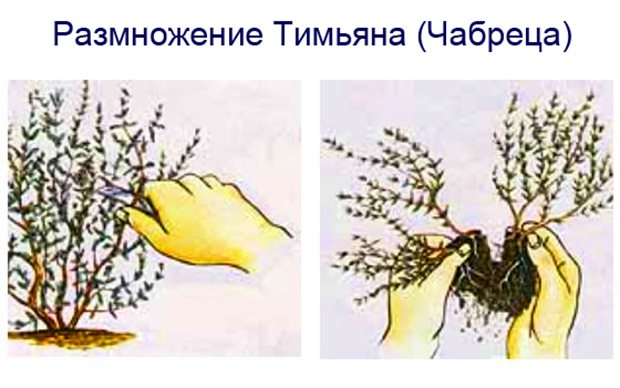
Propagation of thyme bushes
Lemon thyme prefers light and warm plots, the maximum is a light shade, since in shaded places the stems simply grow and do not branch. There should be no through streams of air. The soil is desirable with a neutral to slightly alkaline reaction, light, fertile and with good drainage properties.
For lemon thyme after planting, attention and care are needed. It is not possible to water the thyme bush too often - the plant is not demanding on moisture, on the contrary, it does not like excess water and waterlogging - this is prevented by using gravel, which is added to the soil when planting plants. On rainy days, watering should be completely stopped.
It is not necessary to feed the thyme, it is enough to fertilize the planting site with humus once, and add a liquid vitamin mixture at the end of May. It is necessary to periodically trim overly stretching shoots (about 2/3 of the length), as well as after the flowering period - dried old flowers. The bush is formed precisely with the help of such a small image, which gives it the correct decorative shape. Another useful tip is not to forget and not be lazy to mulch the soil near the thyme bushes with small pebbles, this will give the plants vitality and make their appearance even more attractive.


Mulching the soil near thyme bushes with small stones
Reproduction
There are several ways to propagate a culture:
- seeds;
- cuttings;
- dividing the bush;
Thyme can multiply on its own, so the growth area should be limited with a fence. The seeds are very small and take at least 3-4 weeks to germinate. Before sowing, the soil is dug up and cleaned of weeds, which can be detrimental to the culture.
Important!
Seedlings are planted in the soil at 60-70 days of age.
Many gardeners recommend growing lemon thyme in seedlings. This helps to protect young shoots from natural factors. Ready seedlings are planted in prepared soil. In the summer, thyme is propagated using cuttings. Shoots have excellent rooting ability.
Preparing for winter
In winter, Lemon-smelling thyme can not be covered in the case when winter is not stingy with snow. The plant feels great under the snow.But in the case of snowless winters, it is best to cover it with spruce branches, because it is afraid of severe frosts. No other preparation of thyme for wintering is required.
Lemon-scented thyme will be an excellent garden decoration in the summer. Its aroma will add comfort and warmth. Moreover, in winter, you can enjoy fragrant tea from this plant.
How to protect a plant from pests and diseases?
Lemon thyme has excellent immunity, and most diseases are not terrible for him. Disease prevention is the observance of the rules of agricultural technology and control of soil moisture. Improper care can provoke an attack of insects. Weevils, meadow moths and sandy slugs are dangerous for thyme, but most often aphids attack plantings. Special tools are used to combat pests; you can buy them at any gardening store.
Advice!
After sowing, the seeds can be sprinkled with fine river sand, this will provide seedlings with nutrients and prevent water stagnation.
How to plant outdoors?
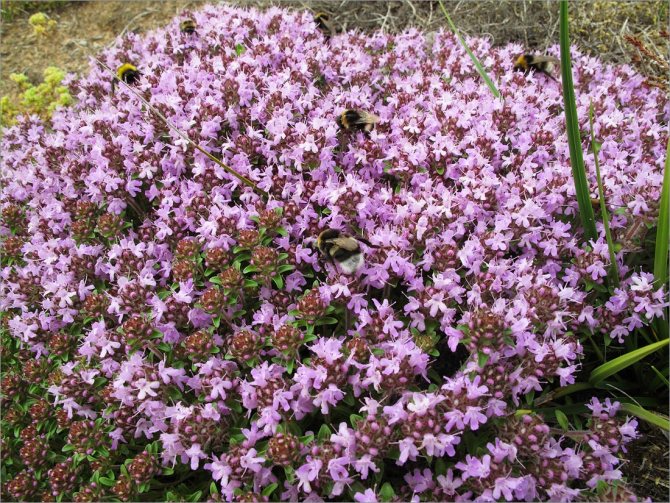

When planting seeds in the ground, they do not need to be soaked in water or growth stimulants. Growing seedlings is also optional. When the soil warms up enough, the seeds can be planted in the garden bed. This usually occurs in early May.
The work is carried out in several stages:
- Shallow grooves should be made with a chopper. The distance between the rows is 300-500 mm, the depth should be about 15-20 mm.
- Pour water over the rows. This will help prevent the appearance of a crust, through which it will be quite difficult for young sprouts to break through. In addition, this method will provide sufficient air and moisture access.
- Thyme has rather small seeds. Therefore, before planting, they should be combined with river sand. The beds are filled with the finished composition. Also, the seeds can not be combined with sand. In this case, it is recommended to evenly sow the grooves, pouring a thin layer of planting material into them.
- Then the beds are covered with a layer of soil. For this it is worth using peat or sand. Ordinary soil is also great. It is important that it is as light as possible and does not contain lumps.
- To achieve a warm and humid microclimate in the garden, it must be covered with a film. You can also use a special covering material.
- Thyme sprouts will appear in about 14-18 days. At this point, you should remove the covering material and ensure sufficient moisture and looseness of the soil. The soil should be loosened between the rows with a small hoe. It is important to get rid of young weeds in time. It should be borne in mind that watering delicate sprouts with a stream of water is prohibited. In this case, a fine spray will do. Moreover, the beds should be poured between the rows.
- When several true leaves appear on the stems, the planting should be thinned out. It is recommended to do this in the evening or in cloudy weather. Weak shoots are recommended to be removed. There should be a gap of about 100 mm between the shoots.
- If it is necessary to remove a strong seedling, it is transferred to another place on the site. Therefore, pulling out the sprouts is not worth it. They must be carefully dug up and taken out with a clod of earth.
- After thinning the thyme, it is recommended to sprinkle with urea solution. To do this, you need to take 20 g of funds in a bucket of water. This manipulation will protect damaged plants from diseases.
- Further, the culture will continue to develop, which will again lead to cramped conditions. When neighboring bushes begin to touch each other with leaves, the plantings need to be thinned again. Leave at least 200 mm between the shoots.
- Then the thyme needs feeding again. For this purpose, any combination fertilizer in liquid form is suitable.
Growing thyme on a windowsill
Thyme can be grown not only on your plot, but also at home in a pot. This will require a medium-sized pot.Drainage is placed on the bottom, the layer should be 2-3 cm thick, the rest of the space is filled with fertile soil, you can buy it or make it yourself from earth, sand and humus. Then the soil is moistened, small depressions are made in it, in which the seeds are placed. Sprinkle them on top with a thin layer of soil mixture and moisten them well.
After the end of planting work, the container is covered with a film or transparent glass. They put it on the south side, while direct sunlight is unacceptable. When shoots appear on the surface of the soil, the shelter is removed. Watering should be moderate, at first it is carried out using a sprayer. After 2 months, the seedlings are thinned out, leaving the strongest ones.
Plant care consists in regular watering, it is carried out when the topsoil dries out. Cut fragrant greens as often as possible, do not allow the thyme to bloom.
Growing a plant at home
You don't have to do anything special to grow lemon thyme. Difficulties with growing will not arise. Thyme is unpretentious and undemanding to conditions. It is enough to fulfill some requirements, and the plant will feel good on the windowsill in a pot.
See also
Growing thyme in the Urals, planting and care featuresRead
You need to purchase a small flower pot with a diameter of 15-20 cm. Choose a sunny place.


You should start with drainage, layer height 2 cm. Then the fertile soil, watered with water and sow thyme seeds. Embedding depth 1 cm, shoots will appear in 10 days. All this time, they carefully monitor the soil moisture, preventing drying out.
After the thyme has risen, it is provided with warmth and sunshine. So the thyme will develop correctly, the plants will not stretch out and will not lose their smell.
Leaves are torn off all the time, do not forget that you do not need to cut off strongly. The plant will weaken or die.
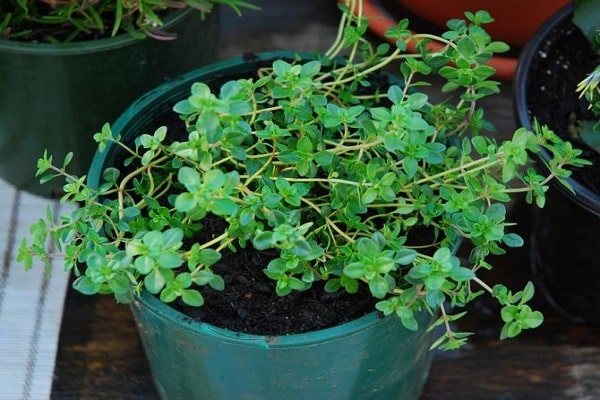

The use of lemon thyme in landscaping
Thyme is not only a great cold remedy and a seasoning that gives dishes a unique flavor, but also a wonderful decoration for the site. The plant is often used by designers in landscape design. Some people sow it instead of the usual lawn grass. In order for a green thyme carpet to be more beautiful, it must be cut more often and not allowed to bloom.
It can be planted on alpine slides and looks great in stone gardens or mixborders. Planting culture in the garden near the gazebo or bench will give you the opportunity to enjoy the wonderful aroma.
The seed can be harvested by yourself or purchased from a gardening store.
The healing properties of Thyme
About the properties of Thyme Theophrastus and Avicenna also wrote. Modern experts claiming that “Thyme helps to open up insecure, sensitive, nervous natures; restores strength and awakens emotions ... "(annotation to one of the patented tonics). So feel free to add Bogorodskaya grass to your dishes and tea (knowing when to stop, of course).
Thyme is considered a very strong antiseptic. It also has anti-inflammatory, analgesic, expectorant, bronchodilator, antispasmodic, weak hypnotic, antihelminthic and many other properties.
Thyme against cough
Thyme effectively treats lung problems. So, with bronchitis or bronchial asthma, thyme infusion will help.
With dry throat, as well as with laryngitis, it will help collection from Thyme with leaves of chamomile and plantain flowers.
Thyme against impotence
In the treatment of prostatitis and impotence regular use will help tea with thyme... You can periodically add St. John's wort, Linden or Rosehip.
Thyme restores strength
Thyme Baths will help recover and cleanse the skin.It is enough to boil the Thyme, filter it and pour the broth into the bathroom. Baths should be taken for about 20 minutes.
Thyme oil it is possible to stimulate biologically active points, thereby adding energy. You can prepare the oil yourself. For which the herb of thyme should be poured with vegetable or olive oil and infused for a month. The longer it is held, the better. Before use, the required amount of oil should be filtered and rubbed clockwise into points on the body.
Thyme - external use
Thyme externally used to treat non-infectious skin rashes, psoriasis, wounds, burns;
Thyme is used for rinsing hair anti-dandruff.
Thyme is used for joint pain, rheumatism, bruises and or stretching, do baths, wraps, compresses with thyme;
Tincture of thyme copes with musculoskeletal pain - it must be used as a rub. To prepare the tincture, half a half-liter bottle should be filled with fresh leaves and flowers of Thyme. Then pour in a couple of glasses of vodka and leave the bottle for 2 weeks to infuse. After that, the tincture is filtered, and the grass is squeezed out. With such a tincture, you can not only rub the joints, but also take it inside after eating, 30-40 drops.
Thyme - Contraindications
The active ingredient of Thyme is thymol. In case of an overdose, thymol can provoke a hyperfunction of the thyroid gland. Also should not be taken Thyme for pregnant women... And also for those who suffer from kidney disease, duodenal ulcer and stomach ulcer.
Medicinal properties of the plant
Thyme has been used by healers even before mainstream medicine. And for good reason, because it contains a substance called carvacrol, it is able to overcome Staphylococcus aureus. The raw material contains:
- essential oils;
- thymol;
- linalool;
They are used to fight fungi, bacteria, microbes. Lemon thyme extract is used in the treatment of the upper and lower respiratory tract. Medicines made from it have anti-inflammatory and expectorant effects. Thyme infusions perfectly help with inflammatory processes in the oral cavity, and also contribute to the elimination of harmful substances and have a beneficial effect on the functioning of the gastrointestinal tract.
Inhalation with the addition of essential oils helps to cope with colds. Decoctions from the leaves in combination with the main treatment help with skin diseases. Even in ancient times, they took aromatic baths with the addition of this fragrant herb. This procedure improves appetite, sleep, and increases blood pressure.
Thyme - interesting facts


Thyme, unlike most antibiotics, is one of the few herbs to which modern microbes cannot develop resistance in any way.
The Slavs used (yut) Thyme to address the Gods... For this, flowering twigs are thrown into the fire, look at the smoke, inhale it. Thyme helps to establish a connection with Gods and ancestors. Thyme is used in many rituals both among the Slavs and among other peoples.
There is still a popular belief in Ireland that you can see fairies with the help of Thyme. To do this, you just need to rinse your eyes with dew from the Thyme bush at dawn after Walpurgis night.
Long time Thyme was a symbol of military valor, masculine strength... Thyme baths and thyme tea were popular pre-battle morale warnings among Roman legionnaires and Scottish Highlanders. In the Middle Ages, noble knights wore scarves with embroidered leaves of Thyme.
Contraindications for use
Like any medicinal plant, not everyone can take thyme. He has some contraindications for use. Medicines containing thyme are not recommended for use in case of:
- pregnancy in any trimester;
- acute and chronic liver or kidney disease;
- urolithiasis;
- hypothyroidism;
- problems in the field of the cardiovascular system;
- gastritis and ulcers;
Important!
In case of an overdose, nausea and sometimes vomiting are observed.
What does Thyme look like
Thyme (Creeping thyme) - a small fragrant shrub up to 30 centimeters high (usually lower in terms of what spreads along the ground).
Thyme stalk thin, brown, creeping, woody at the base, often takes root, while forming additional roots.
Thyme leaves small oval, with white cilia along the edge.
Flowers of Thyme pink-violet or pink, two-lipped, collected in loose heads.
Thyme cannot be confused with another herb due to its special structure and bright fragrant aroma. Once, you will no longer confuse his smell with anything.
Cooking use
Lemon thyme is also used in cooking. It is added to fish and meat dishes, and it will also add originality to any vegetable salad, baked or stewed potato. Many add thyme to compotes and various kinds of preservation. The first courses will have an interesting aftertaste with the addition of fragrant seasoning. Putting a small amount of thyme in fatty foods, such as lamb or duck, will improve digestion and shorten the digestion time of the food.
In summer, thyme is consumed fresh. For the winter, you can make supplies by drying or freezing it. Even with prolonged heat treatment, it will not lose its taste, thyme can be added to the dish even at the initial stages of cooking.
Combination with other plants
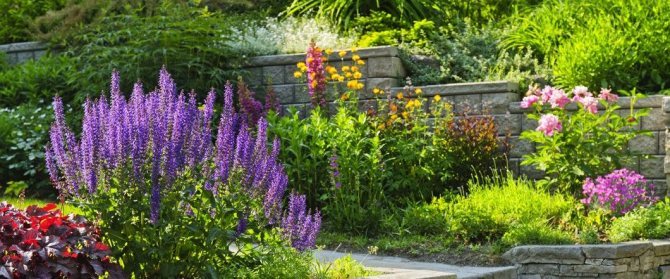

The noble greenery of thyme creates a favorable backdrop for many garden plantings with bright colors. Among them:
- pion;
- chrysanthemums;
- roses;
- lilies;
- tulips;
- daffodils and others.
In a mixborder, thyme is planted between the plants in a creeping carpet or as a framing for a composition. In the rock garden and other stone ensembles, the garden plantation is often "adjacent" to conifers. It can be both large trees (pine, spruce, thuja) and undersized representatives of the culture (undersized juniper varieties, dwarf pine).
Harvesting and storage
Harvested throughout the summer, thyme is usually not harvested in the first year. For storage, it is harvested from the second year of life. Do this carefully, trying not to damage the roots, otherwise the bushes may die. For the preparation of decoctions and infusions for medicinal purposes, the entire terrestrial part of the culture will be needed. Leaves are mainly used in cooking, sometimes stems.
For storage, it can be put in the freezer, but it is still more often dried. The crop is collected in small bunches and hung in a dry, well-ventilated room, protecting from direct sunlight. Or the collected thyme is laid out in a thin layer until completely dry, and then crushed. You can store thyme for two years in a moisture-proof container; a glass jar with a lid is perfect for this.
Culture information
A unique genus of thyme is a semi-shrub belonging to the family of the lamb family. It covers more than four hundred species distributed throughout Russia.
The southern territories of the European continent are considered the birthplace of this unique plant. Today, wild forms of thyme are found in the northwest of the Mediterranean. Another name for the thyme genus is thyme. It was used by ancient Roman and ancient Greek soldiers to raise the military spirit and vitality. In ancient Russia, they tried to protect themselves from evil spirits with thyme and decorated the icons of the Mother of God (therefore, another name for thyme is "theotokos' grass").
Nowadays, thyme is used mainly for decorating exteriors, for example, such a variety as low-growing mossy thyme. However, most often lemon thyme (lemon-smelling) is used for these purposes, so named for its characteristic citrus scent.


Lemon thyme
It is a natural hybrid of the species pulegioides and vulgaris, with a description of the end Xvi century, consists of many varieties, such as:
- Bertram Anderson is a shrub with golden foliage;
- Spicy Orange - has flowers of a light purple hue and long leaves;
- Gold Edge - has a pleasant smell and is used in cooking;
- Golden King - the leaves have a yellow border;
- Silver Queen - blooms in lilac-pink color, leaves are small, silvery-white (which gave the name to the variety).
Testimonials
Tamara
I have been treating myself with herbs almost all my adult life, I do not recognize these newfangled pills. On the site I grow various medicinal plants, including thyme. About five years ago I planted lemon thyme seeds, I really liked the smell, and it is suitable not only for medicinal broths. Recently I have been adding it to almost all dishes, my husband really likes the unusual taste.
Alyona
My grandmother rewrote the dacha to me, since she herself is no longer able to manage there, her health does not allow. A lemon-scented thyme grows on the site, it immediately attracted my attention with a pleasant aroma. I never liked herbal teas, but I liked the hot drink from it. In care, the culture is completely unpretentious, I water it occasionally, in the spring I added complex mineral fertilizers to the water. The only thing for the winter it is necessary to cover it, for this I used agrofibre, and sprinkled it on top with foliage and covered it with branches.
Traditional medicine recipes with common thyme
Thyme is one of the popular herbs in folk medicine. Infusions, decoctions, teas, ointments are created from it.
- Tea helps with colds, coughing, asthma attacks, muscle cramps from convulsions pass. Tea is drunk in case of digestive problems, the remedies raise the sense of taste. They improve the functioning of the gastrointestinal tract, defecation normalizes, spasms pass and the formation of gases decreases.
- Baths with healing ingredients used to relieve signs of rheumatism, bowel disease, cough for colds. The plant in the form of baths removes belching, reduces flatulence. The procedure will cure patients with laryngitis, bronchitis and tracheitis.
Infusions are often prepared... They are used externally, for rinsing, lotion formulations.
Infusions
- From cough: 1 tablespoon pour 100 ml of boiling water. The liquid is put on fire, heated for 15 minutes. The obtained solution is filtered, before taking, boiling water is added to the original volume. Dosage - 1 tablespoon before breakfast, lunch and dinner.
- For taking medicated baths: 100 g of grass is poured over 2 liters of water. The composition is put in the oven for languishing. Cooking time - 40 minutes. After evaporation, the mixture is filtered and added to the bath.
- Herbal cough collection... The components of the composition are thyme (10 g), anise (5 g), primrose root (5 g), sundew (5 g), plantain leaves (5 g). All herbs are mixed and poured into a glass of hot boiling water. Drinking begins after straining 1 cup in a warm state.
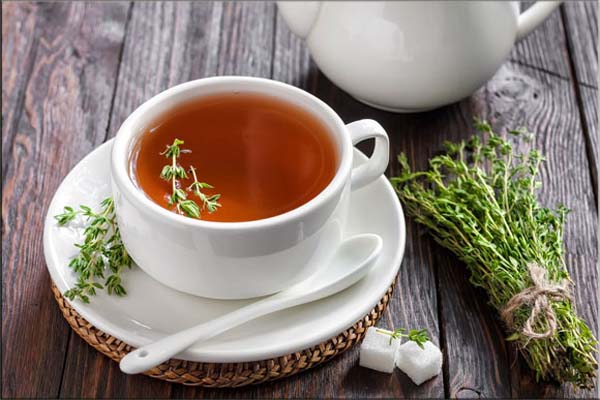

Tincture for alcohol
You will need 150 g of fresh grass. It is finely chopped, placed in a glass container. Pour 300 g of water. The bottle is left to ferment for 20 days in a warm room. Shake periodically. For treatment, the strained mixture will have to be divided into small bottles. Tincture gargle to relieve inflammation.
Essential oil
From the thyme, oil is extracted from the leaves during the flowering of the shrub. Extraction procedures:
- distillation - evaporation;
- rectification - removal of toxins.
Oil improves appetite, boosts immunity, protects against inflammation and infections, oil has a special role in the treatment of the respiratory tract. Toxins, microbes that have affected the genitourinary system are excreted from the body. Women create medications from the herb to relieve pain during menstruation. The oil has its own contraindications: pregnancy, epilepsy, hypertension.



